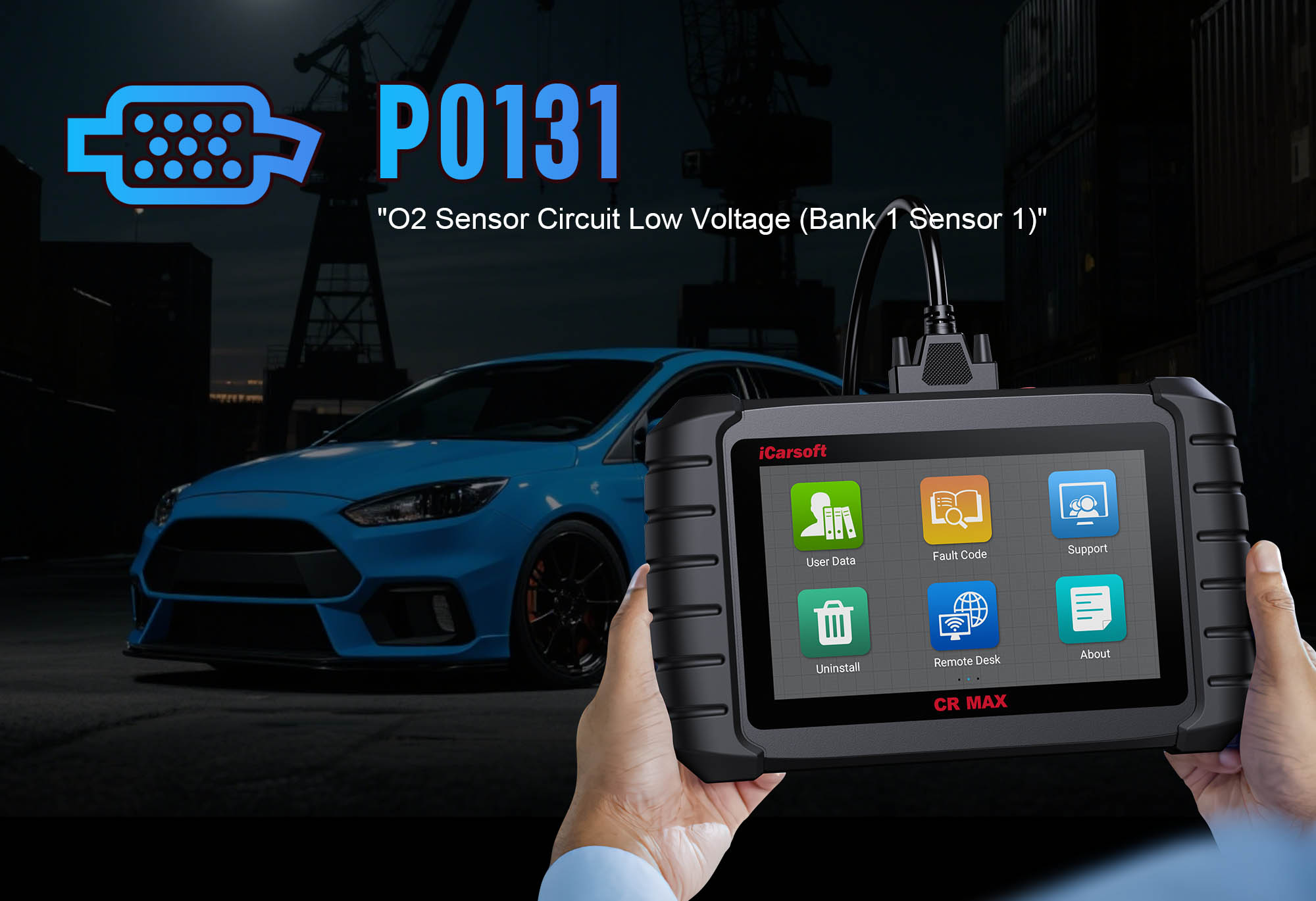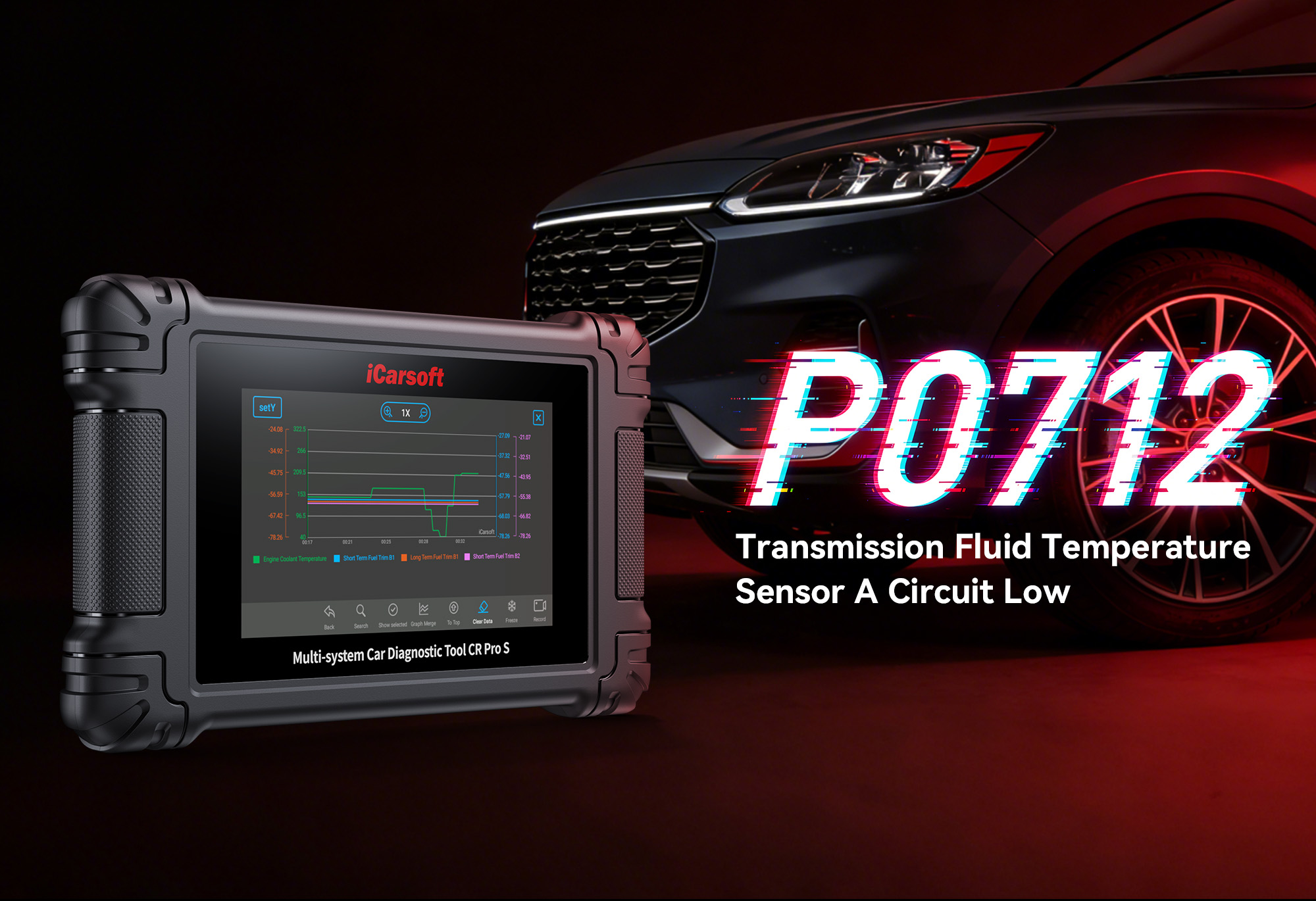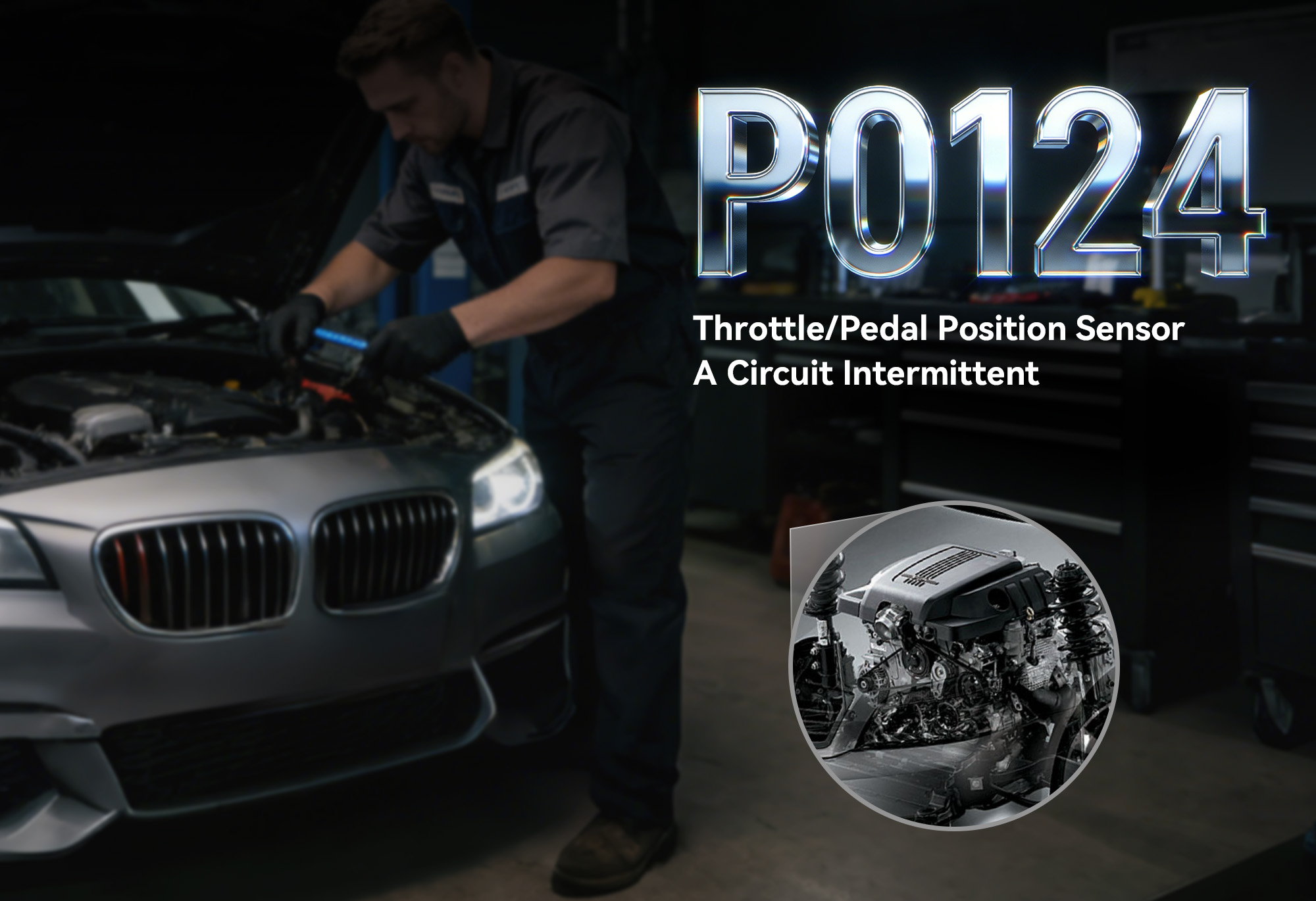Diagnose & Clear P0131 with iCarsoft CR MAX: Fix Oxygen Sensor Circuit Issues
If your check engine light illuminates and a scan returns P0131, your vehicle is signaling a problem with its oxygen sensor system. This generic OBD-II code stands for "Oxygen Sensor Circuit Low Voltage (Bank 1, Sensor 1)"—meaning the Engine Control Module (ECM) has detected abnormally low voltage from the primary oxygen sensor in Bank 1.
Oxygen sensors (O2 sensors) monitor the oxygen content in exhaust gases, providing critical data to the ECM to adjust fuel injection and maintain the optimal 14.7:1 air-fuel ratio. Bank 1 refers to the cylinder bank containing cylinder #1, and Sensor 1 is the "upstream" sensor located before the catalytic converter. When P0131 occurs, the sensor’s voltage output stays below 0.1V (indicating a lean condition), causing the ECM to enrich the fuel mixture excessively—leading to poor fuel economy, increased emissions, and potential catalytic converter damage.
Basic scanners might only label P0131 as an "O2 sensor fault" but can’t distinguish between a failing sensor, damaged wiring, or an exhaust leak. The iCarsoft CR MAX solves this with sensor-specific diagnostics, real-time voltage monitoring, and vehicle-specific O2 sensor locations. Let’s walk through how to diagnose and resolve P0131.
Why It Matters
Ignoring P0131 may seem minor, but it triggers a chain reaction of performance and reliability issues. The ECM’s overcompensation for low O2 sensor voltage wastes fuel (increasing consumption by 10–20%) and floods the catalytic converter with unburned fuel—over time, this can melt the converter’s internal substrate (a $800–$1,500 repair). Additionally, a persistently lean fuel mixture (signaled by P0131) can cause engine misfires, which damage piston rings and valves.
For vehicles in emissions-testing states, P0131 will cause a failed test—costing you time and re-test fees. Addressing P0131 promptly with the iCarsoft CR MAX not only restores fuel efficiency but also protects critical engine and emissions components.
Understanding P0131: Causes & Key Symptoms
To tackle P0131 effectively, first map its impact on your vehicle’s O2 sensor and fuel systems:
Key Symptoms of P0131
-
Illuminated Check Engine Light: Activates when Bank 1, Sensor 1 voltage remains below 0.1V for 10+ consecutive seconds.
-
Poor Fuel Economy: The ECM enriches the fuel mixture to counteract "lean" readings, increasing gas usage by 10–20%.
-
Rough Idle or Hesitation: Erratic fuel-air ratios disrupt combustion, causing shaking at idle or lag during acceleration.
-
Increased Emissions: Unburned hydrocarbons (HC) and nitrogen oxides (NOx) spike—fails state emissions tests.
-
Catalytic Converter Overheating: Rich fuel mixtures burn in the converter, leading to a "rotten egg" smell (sulfur) or premature failure.
Common Causes of P0131
|
Cause
|
Description
|
|
Faulty Oxygen Sensor
|
Internal heater failure or worn sensing element (platinum electrode) prevents the sensor from generating normal voltage (0.1V–0.9V).
|
|
Wiring Issues
|
Damaged insulation, corrosion in connectors, or loose terminals disrupt voltage transmission between the sensor and ECM.
|
|
Exhaust Leaks
|
Leaks before Bank 1, Sensor 1 (e.g., manifold gaskets, exhaust flange) draw in fresh air, mimicking a lean exhaust and lowering sensor voltage.
|
|
Low Sensor Heater Voltage
|
Blown "O2 Sensor Heater" fuses or weak batteries reduce power to the sensor’s heater—delaying warm-up and causing low-voltage readings.
|
|
ECM Problems
|
Rare, but a failing ECM may misinterpret sensor signals or supply insufficient voltage to the sensor circuit.
|
Why iCarsoft CR MAX Excels at Diagnosing P0131
Basic OBD-II scanners can’t isolate O2 sensor-specific issues, but the iCarsoft CR MAX is tailored to oxygen sensor diagnostics with these key features:
Sensor-Specific Data
Targets Bank 1, Sensor 1 with preloaded specs (heater resistance, voltage ranges) for Hyundai Sonata, Ford Escape, BMW 3 Series, and most makes/models.
Real-Time Voltage Monitoring
Displays live O2 sensor voltage (should fluctuate 0.1V–0.9V when warm) to spot stuck low readings that trigger P0131.
Heater Circuit Tests
Verifies the sensor’s internal heater operation (resistance 10–15Ω) and voltage supply—critical for quick warm-up and accurate readings.
Exhaust System Diagrams
Shows exact locations of Bank 1, Sensor 1 and potential leak points (manifold gaskets, flange connections) to speed up inspections.
Fuel Trim Analysis
Compares short/long-term fuel trim values (positive = ECM enriching) to confirm lean trends caused by P0131.
Auto VIN Detection
Automatically identifies engine configuration (inline/V-engine) to ensure accurate Bank 1/Sensor 1 numbering—avoids misdiagnosis.
Step-by-Step: Diagnose P0131 with iCarsoft CR MAX
-
1. Connect & Confirm the Code
Plug the CR MAX into your vehicle’s OBD-II port (under the dashboard) and power it on. Select your vehicle via Auto VIN (fast and accurate) or manual entry (make/model/year). Navigate to Engine > Fault Codes > Read Codes to confirm P0131. Tap Code Details for vehicle-specific insights (e.g., "Hyundai: Bank 1 Sensor 1 Voltage Below 0.08V" or "Ford: O2 Sensor 1 Circuit Low Input").
-
2. Check for Related Codes
P0131 rarely appears alone—scan for these companion faults to narrow the root cause:
- P0130: Bank 1 Sensor 1 Circuit Malfunction (general circuit issue)
- P0171: System Too Lean, Bank 1 (confirms lean condition triggering P0131)
- P0030/P0031: O2 Sensor Heater Circuit Faults (heater power issues)
- P0133: Bank 1 Sensor 1 Response Slow (worn sensor, not just low voltage)
Address these first—multiple codes may signal a shared problem (e.g., exhaust leak).
-
3. Locate Bank 1, Sensor 1
Use the CR MAX’s Component Location tool to find the sensor:
- Bank 1: Cylinder bank containing cylinder #1 (inline engines: frontmost cylinder; V-engines: check diagram—e.g., GM V8: Bank 1 = driver’s side).
- Sensor 1: Upstream of the catalytic converter (mounted in the exhaust manifold or header, with a 4-wire connector: 2 for the sensor, 2 for the heater).
Note the sensor’s position to avoid confusing it with the downstream Sensor 2.
-
4. Monitor Live O2 Sensor Data
Use the CR MAX’s real-time data to spot voltage irregularities:
1. Go to Engine > Live Data > Oxygen Sensors and select:
- "Bank 1 Sensor 1 Voltage" (target: 0.1V–0.9V fluctuation when warm)
- "Sensor 1 Heater Voltage" (12V when active, drops as sensor reaches 600°F operating temp)
- "Short-Term Fuel Trim (Bank 1)" / "Long-Term Fuel Trim (Bank 1)" (positive values = ECM enriching)
2. Start the engine and let it reach operating temperature (10–15 minutes, or until coolant temp reaches 190°F):
- Voltage stuck <0.1V = faulty sensor, exhaust leak, or wiring issue
- No heater voltage = blown fuse or heater circuit problem
- Fuel trims >10% = ECM compensating for lean readings
-
5. Inspect the Sensor & Wiring
Visually examine Bank 1, Sensor 1 and its circuit (ensure exhaust is cool):
- Sensor Body: Check for oil contamination (sign of leaking valve cover gasket), carbon buildup, or physical damage (dents, cracks).
- Electrical Connector: Inspect for green/white corrosion, bent pins, or water intrusion—clean with electrical contact cleaner.
- Wiring Harness: Look for frayed insulation, cuts, or damage where the harness touches hot exhaust components (e.g., manifold).
-
6. Test the Heater Circuit
A functional heater is critical for O2 sensor accuracy—test with the CR MAX:
1. Turn off the engine and disconnect the Bank 1, Sensor 1 connector.
2. Navigate to Special Functions > Engine > Sensor Tests > O2 Sensor Heater.
3. Select "Bank 1 Sensor 1" and follow prompts to measure heater resistance:
- Normal range: 10–15Ω (varies by make—check CR MAX’s specs)
- Readings = 0Ω (short) or "OL" (open loop) = heater failure (replace sensor)
-
7. Check for Exhaust Leaks
Leaks before the sensor draw in air, causing low voltage—diagnose with the CR MAX’s guidance:
1. Use the CR MAX’s Exhaust System Diagram to identify common leak points:
- Exhaust manifold gaskets
- Flange connections (manifold to downpipe)
- Exhaust manifold cracks
2. With the engine idling, listen for ticking/hissing sounds near these points (use a mechanic’s stethoscope for hard-to-reach areas).
3. Spray soapy water on suspect areas—bubbles forming = leak (mark for repair).
-
8. Verify Power Supply
Ensure the sensor receives proper voltage from the ECM:
1. Keep the Bank 1, Sensor 1 connector disconnected.
2. Turn the ignition to "ON" (engine off).
3. Use the CR MAX’s multimeter function to check for 12V at the heater power pin (refer to the CR MAX’s wiring diagram for pin location).
4. Results:
- No voltage = blown "O2 Sensor Heater" fuse (locate via CR MAX’s Fuse Diagram) or broken wire
- 12V present = power supply is healthy
-
9. Repair & Clear P0131
Fix the root cause based on diagnostics:
- Faulty Sensor: Use the CR MAX’s Part Lookup to find OEM sensors (e.g., Denso 234-4021, Bosch 13477). Apply anti-seize compound to the sensor threads (avoid getting on the tip) before installation.
- Exhaust Leaks: Replace worn gaskets, tighten loose flanges, or weld small cracks (severe cracks require manifold replacement).
- Wiring Issues: Splice frayed sections with heat-shrink connectors; replace corroded connectors and apply dielectric grease.
- Blown Fuse: Replace the "O2 Sensor Heater" fuse (check CR MAX’s Fuse Diagram for amperage—typically 7.5A–15A).
Clear the code: Navigate to Engine > Fault Codes > Clear Codes to delete P0131.
-
10. Verify the Repair
1. Take a 20-minute test drive, including highway speeds (ensures the sensor reaches operating temperature).
2. Use the CR MAX’s Data Logging to record:
- Bank 1 Sensor 1 voltage (should fluctuate 0.1V–0.9V)
- Short/long-term fuel trims (should return to ±5% of 0)
3. Re-scan after the drive:
- No P0131 + normal voltage/fuel trims = successful repair
- Code returns = revisit exhaust leak or wiring tests
Preventing P0131 Recurrence
Use the iCarsoft CR MAX to maintain healthy O2 sensor performance and avoid future P0131 faults:
-
Sensor Maintenance: Replace O2 sensors every 60,000–100,000 miles (set reminders via the CR MAX’s Service Reminder).
-
Exhaust Inspections: Check for leaks during oil changes—address rusted manifolds or loose flanges promptly.
-
Wiring Protection: Secure O2 sensor harnesses away from hot exhaust parts with zip ties to prevent insulation damage.
-
Fuel Quality: Use Top Tier detergent gasoline to reduce carbon buildup on sensor tips (avoids false lean readings).
-
Battery Health: Run the CR MAX’s Battery Test quarterly—weak batteries (below 12V) reduce heater power to the sensor.
Summary Table
|
Step
|
Action
|
|
1
|
Connect CR MAX, confirm P0131, and review vehicle-specific code details
|
|
2
|
Scan for related O2 sensor/fuel trim codes to narrow root cause
|
|
3
|
Locate Bank 1, Sensor 1 using Component Location tool
|
|
4
|
Monitor live O2 sensor voltage, heater voltage, and fuel trims
|
|
5
|
Inspect sensor body, connector, and wiring for damage
|
|
6
|
Test O2 sensor heater resistance to check for failure
|
|
7
|
Check for exhaust leaks before the sensor using soapy water
|
|
8
|
Verify 12V power supply to the sensor’s heater circuit
|
|
9
|
Repair faulty components and clear P0131
|
|
10
|
Test drive, log data, and re-scan to confirm repair
|
Conclusion
P0131’s "low voltage" label can be misleading—what seems like a faulty O2 sensor might actually be a simple exhaust leak or blown fuse. The iCarsoft CR MAX eliminates guesswork with sensor-specific tools, real-time monitoring, and exhaust system guidance, ensuring you fix the root cause (not just replace parts).
Whether you’re replacing a worn sensor, fixing a manifold leak, or repairing wiring, the CR MAX guides you through every step—saving time and avoiding unnecessary costs (OEM O2 sensors cost $50–$200, so misdiagnosis wastes money). By resolving P0131 promptly, you’ll restore fuel efficiency, pass emissions tests, and protect your vehicle’s engine and catalytic converter for years.
FAQs About P0131 Code
Q: Can I drive my vehicle with P0131?
A: Short trips (e.g., to a repair shop) are possible, but avoid long drives. The ECM’s rich fuel mixture wastes gas and damages the catalytic converter—if you notice a "rotten egg" smell or rough idle, stop driving immediately. Prolonged operation can also cause engine misfires that wear piston rings.
Q: Will replacing the O2 sensor always fix P0131?
A: No—only if the sensor itself is faulty. The CR MAX’s tests confirm this: if heater resistance is outside specs or voltage stays low despite no exhaust leaks, replace the sensor. If leaks are present or wiring is damaged, replacing the sensor ($50–$200) won’t resolve P0131.
Q: How do I tell Bank 1 from Bank 2 in a V-engine?
A: Use the CR MAX’s Component Location tool—after Auto VIN detection, it labels Bank 1 as the cylinder bank containing cylinder #1. As a general rule:
- GM/Chevrolet: Bank 1 = driver’s side
- Ford: Bank 1 = passenger’s side
- BMW: Bank 1 = side with cylinder #1 (near the front of the engine)
Q: How much does it cost to fix P0131?
A: Costs vary by cause: O2 sensor replacement = $50–$200 (DIY); Exhaust gasket replacement = $20–$80 (DIY); Wiring repair = $100–$300 (professional); Catalytic converter replacement = $800–$1,500 (professional). The CR MAX helps avoid expensive fixes by identifying low-cost issues first.





